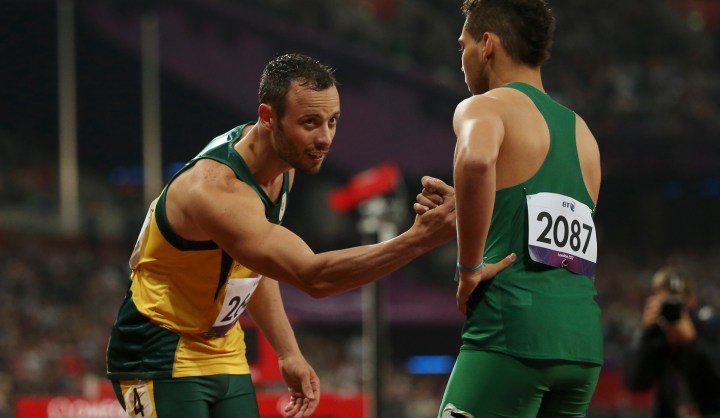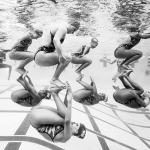Sport
Pistorius: not taking defeat in his (long) stride

Talk about a storm in a teacup. Oscar Pistorius is in the middle of a controversial media frenzy about blades, strides and unfair advantages. All of which is overshadowing the achievements of a 20-year-old from Brazil – and it doesn’t look like it’s letting up any time soon, writes ANT SIMS.
Just minutes after Oscar Pistorius suffered a shock defeat to Brazil’s Alan Oliveira in the 200m final at the London Paralympic Games, South Africa’s Blade Runner complained about the length of his competitor’s blades. Unlike reports would have you believe, it wasn’t the first time that Pistorius complained about it, but the timing of his outburst couldn’t have been worse.
Pistorius was the darling of the Olympics and the poster boy for the Paralympics, and while his outrage was somewhat understandable – after complaining about his competitor’s legs before, and then being beaten in his speciality race right after smashing the world record – it’s understandable that Pistorius was irked.
However, British media latched on to his outrage, and now he can’t back down.
“This is a really strong race of mine, and as I said in the mixed zone, some of the other guys’ legs are unbelievably long,” Pistorius told Britain’s Channel 4 after the race.
“Not taking anything away from Alan – he’s a great athlete, but the guys who do the measuring in the courtrooms… some of these guys are a lot taller, and you can’t compete for stride length.
“We’re not racing a fair race. The International Paralympic Committee (IPC) has the regulations, but the regulations allow the athletes to make themselves unbelievably high. We tried to address the issue in the weeks leading up to this, but it fell on deaf ears.
“The guys are running ridiculous times. Alan is a great athlete, but I run just over 10 metres per second, so I don’t know how you can come back from eight metres behind after 100m to win. It’s ridiculous.”
It was an untimely tirade and Pistorius has since apologised, qualifying the outburst by explaining that he really does believe there is a serious issue. But is there?
The IPC Rules and Regulations do put Pistorius in a position to have his competitors investigated. Under these rules and regulations, the IPC states that technology which gives athletes an “unrealistic enhancement of stride length” are prohibited, and athletes who feel that this rule is breached are within their rights to appeal and put forward a complaint which could bar those accused of breaching the rules and regulations from competing.
The IPC also has rules in place for maximum height of prosthetics, however, and all athletes running had their equipment passed as legal.
“Since 2010, we have had rules in place whereby in international competition we measure athletes in the call room prior to a race,” said IPC media and communications director Craig Spence.
“Last night (Sunday) we measured all eight athletes in the call room prior to competition. This was done by an international classifier. They were measured, we had the signature of the classifier and all eight were legitimate to race.”
The saga is likely to drag on for some time. The IPC is set to meet with Pistorius in the coming days to listen to his concerns about prostheses. Spence and Pistorius had a telephonic discussion six weeks ago, but the athlete was told that there were no infringements from his competitors. If the scientific strides are anything to go by, the meeting is likely to yield the same result.
“We will listen to Oscar’s questions on whether variation in that height is something we need to look [at]. At the moment, the rules go with the maximum allowed height. When these formulas were developed, they were discussed with athletes and coaches, and feedback [was] collected,” said Spence.
One of Pistorius’ main concerns is that, under the current rules, athletes can change height at will as long as they remain within the legal limits of the IPC formula.
Pistorius makes use of 184cm blades because he uses Cheetah blades, which are sanctioned for non-disabled competition. Under the IPC rules, though, he could wear prosthetics which extend his height to 193cm.
Oliveira changed his prosthetics just three weeks before the Paralympics, switching to 181cm blades on advice from his coach. The IPC formula which estimates the height of the athlete and adds 3.5% to allow for the fact that they run on their toes rather than their heels, allows Oliveira to use blades of up to 184cm.
“The coaches and I decided to try a higher blade. I tried the new height for the first time last year and it was difficult to get used to them. I decided to try them again earlier this year and it went a little bit better. Three weeks ago, we decided to really go for it,” the Brazilian said.
“The prosthetics don’t run alone. Of course they are good for an improvement, but there is not a significant time difference.”
His concerns regarding the chopping and changing of length at will boil down to Pistorius’ belief that longer blades help athletes increase their stride length, but a sports scientist has blown this theory out of the water, as explained further below.
Oliveira’s strides were actually fewer and shorter than his, and the South African Blade Runner took more strides than his competitor. There is more to running – with or without prosthetics – than simply taking strides. It’s a complex and intricate art which relies on various factors to come together as a whole.
Considering his stature, also, Pistorius’ outburst is rather peculiar. He has a wealth of experience and should know better than anyone that running is about more than the vehicles which extend from your hips. He proved this when he took part in the able-bodied Olympics, just as he did with some remarkable performances over the last few years.
Sport scientist Ross Tucker analysed the race and found that Pistorius took 92 steps (at an average of 2.2m per stride) while Oliveira took 98 steps to win gold (2m per stride).
Breaking it down further, Pistorius took 49 steps (2.0m per stride) in the first 100m and 43 steps in the straight (2.3m per stride). Oliveira, on the other hand, took shorter strides: 52 in the first 100m (1.92m each) and 46 in the second 100m (2.2m each).
Therefore claims of being unable to compete with stride length are somewhat misguided. Scientifically speaking, Oliveira simply won because of leg speed. As in all sports, sometimes athletes just get beaten because their competitors are better on a given day.
Pistorius is back in action on Wednesday in the T44 100m and the 4 x 100m relay, and on Saturday in the 400m. Oliveira, too, will be in both the races. And after the fuss of the 200m, things will surely be interesting. DM
Photo: South Africa’s Oscar Pistorius (L) congratulates Brazil’s Alan Oliveira after Oliveira won the men’s 200m T44 classification event at the Olympic Stadium during the London 2012 Paralympic Games September 2, 2012. This classification is for athletes with an impairment that affects their arms or legs, including amputees. REUTERS/Olivia Harris


















 Become an Insider
Become an Insider